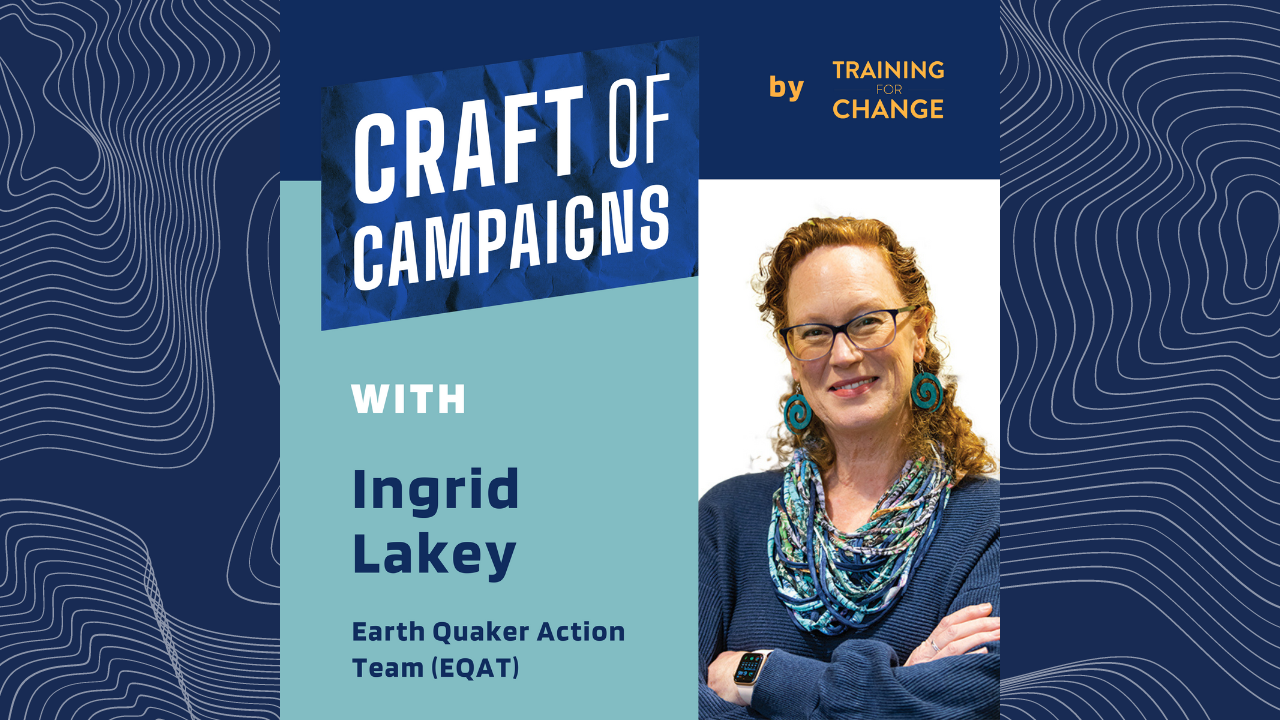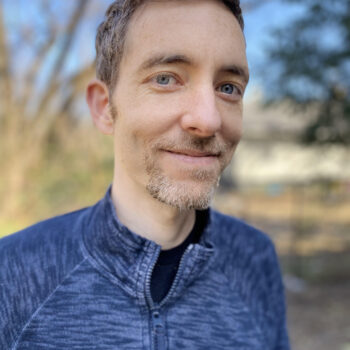Most of the campaigns we’ve profiled in Craft of Campaigns were designed by groups or coalitions with a vision – the campaign was a way to get from the status quo to their visionary future. In some cases, that vision was purely about playing defense – they just wanted to stop something bad from happening, like a new Amazon headquarters or police training facility. In others, they wanted to build their organization, like Southerners on New Ground’s Free From Fear campaigns. But today’s campaign story, to get the country’s sixth-largest bank to stop financing coal mining, was initiated as a skill-building intervention by a group that really only got started for the purpose of running this campaign. Unlike other campaigns, this one is a great example of having a laser focus on a campaign and a campaign objective and building organizational structures around it, rather than having an existing organizational structure that a campaign is incubated within.
This story involves a group of Quakers, or people who belong to the Religious Society of Friends, so let me take a minute to say a little about who they are. These progressive Christians have played supporting roles in nearly every significant social movement in American history. I’m standing in Guilford County, North Carolina, which happens to have been a major Quaker settlement in the 18th century. Their pacifist and anti-slavery values led to this county voting against seceding during the Civil War and to being a major hub for the Underground Railroad. Alice Paul and Susan B. Anthony were just two of many Quaker suffragettes, and Bayard Rustin, raised Quaker, got his first organizing job in the 1930s at a local Friends Meeting, which is what Quaker congregations are called. Quaker activists, who are predominantly but, like Rustin, not exclusively white, have been especially influential in the Philadelphia area.
And while most of us have become accustomed to seeing Muslim and Jewish activists leading significant protests in 2024, it may be a little disorienting to imagine largely white Christians organizing dozens of civil disobedience actions against fossil fuel companies in 2011. So prepare yourself, that’s where we’re headed.
But this story starts in 2009, when climate change organizing wasn’t yet in the mainstream the way it is today. We begin at a conference for Philadelphia-area Quaker activists who wanted to explore how to take action on climate change. One of the conference speakers, a longtime campaign organizer and direct action trainer named George Lakey, suggested to the crowd that, rather than the individual actions middle-class white people were obsessed with at the time, like recycling and using LED light bulbs, activists needed to interrupt the companies who produced the most climate pollution and had to learn how to become a disruptive force as previous movements had done. Someone in the crowd challenged him to teach them and he invited anyone interested to start meeting at his home.
A study group formed, exploring topics like how successful campaigns had achieved their goals and what strategies they had in common. They also began cutting the issues related to climate change. They zeroed in on coal, and specifically mountaintop removal coal mining. A vibrant Appalachian resistance movement rooted in the mountains of West Virginia and Virginia had been active for several years, struggling to stop the destruction of an ecosystem spanning several states. And much as today’s gas pipeline fighters in Louisiana, Texas, and Virginia must find leverage outside of the environmental regulators that have been captured by corporate interests, they also needed to find other leverage points that could stall mountaintop removal – like the corporations that financed mine operators.
The study group mapped the pillars of support that allowed the coal mine operators to rip apart forests and streams and realized one of the pillars ran straight into their backyards. PNC Bank, based in Philadelphia, was one of the largest financiers of mountaintop removal. But it didn’t have to be that way: the bank could easily adopt a policy excluding loans to mountaintop removal mining companies. But it would cost PNC some not-insignificant amount of the bank’s profits. To win a demand like that policy the activists in the study group, who decided to name themselves EQAT (Earth Quaker Action Team), would have to cause or threaten to cause them even more lost revenue or higher costs in the form of brand damage or lobbying expenses, from targeting the bank’s own pillars of support. PNC not only described themselves as a Quaker bank, which they had been before a wave of corporate mergers, but also marketed themselves as ‘the greenest bank’.
Having landed on a target and a demand, it was time to pick strategies and tactics that would get EQAT past the campaign mile markers that would constitute what’s sometimes called the critical path to victory, like forcing the company to respond publicly to criticism of its climate lending practices for the first time ever. The group knew they wanted to focus on recruiting one constituency, Quakers, to get involved in climate. But unlike many activists with a focus on recruitment, they didn’t primarily think of themselves as organizers or basebuilders. Rather, they thought it was more important to develop a smaller group of Quakers committed to disruptive action than build a mass base of Quakers taking action on climate. They very intentionally crafted an organization with a rebel identity, rather than an organizer or basebuilder identity. And they had diagnosed another movement tendency: what today’s guest, Ingrid Lakey, describes as a scattershot approach to activism – a passing emphasis on “whatever’s popping up,” rather than focusing on one campaign over time.
All of this studying and cutting an issue and planning took place over the winter of 2009, and in the spring of 2010 EQAT moved into what Ingrid, in this interview, describes as their first phase of ‘practice’ direct actions in May and April. As she put it, these were actions intended to ‘limber up our muscles’ – like attempting to deliver a quilt to the bank’s regional president, while holding a Quaker worship service – and to raise the issue more visibly within Philadelphia activist circles. Their actions became more dramatic later that summer, building a small mountain in a bank branch lobby as part of a regional day of action, which Ingrid still describes as EQAT trying some things out, and at the same time, building more and deeper connections with Appalachian land defenders, which helped them recruit more Quakers into the fight. In February 2011 the campaign began generating more heat on PNC Bank by way of a secondary target, the Philadelphia Flower Show, which the bank treated as a huge advertisement for its green credentials and local corporate roots. EQAT sent in a team dressed as an imaginary Flower Crimes Division to occupy part of the expo and were surprised that the host organization, the Horticultural Society, fearing even more bad publicity, discouraged the police from arresting their members.
Continuing to find new ways to keep the pressure on and recruit more activists outside Philly, the group led a 200-mile march to the bank’s headquarters in Pittsburgh, holding actions in branch lobbies and conducting trainings along the way. By late 2012 they had so expanded their ability to recruit, train, and host actions, they could hit fifteen branch actions in multiple cities on the same day. The next year, it was sixteen branches in just the bank’s hometown, channeling the energy of student climate activists in town for a convention. When the bank moved its annual meeting to Florida to escape the group’s attention, they connected with high school and college students from the state who had reached out about getting involved, and for the second year in a row shut down the meeting within minutes of it getting started, generating negative attention in the financial industry press.
In this interview, you’ll hear Ingrid reflect on how the group only slowly realized the importance of creating structures to absorb new activists, including incubating campaign organizing committees around the country. This was years before the 2016 Bernie campaign set the standard for those structures, but still EQAT managed to recruit and train campaign committee leaders years before the rest of us were using Zoom. And in 2013 they were able to pull off a day of action that hit PNC locations in thirteen states. From the bank’s point of view, EQAT was roughly doubling its capacity to mobilize every year, rather than sending the same group of people to an annual meeting protest over and over. And their campaign escalations appeared unpredictable and built on each other. And just like today’s faith-based direct action formations, many secular activists ended up joining EQAT or started PNC Bank campaign committees in other states, making it more difficult for the bank to discredit the group, particularly when dozens of high school students began joining in.
Not only did the campaign achieve its public-facing, external goal, becoming what is still the only successful grassroots effort to force a financial institution to change its climate lending away from fossil fuel expansion projects, their internal goals were met as well. The actions EQAT planned required a bold, confrontational approach from participants, and the group’s recruitment tactics leaned heavily on civil disobedience trainings to encourage readiness for confrontation.
And those actions consistently targeted a single pillar of support, the bank’s public image. Even when EQAT recruited bank customers to publicly close their accounts and move their money to another financial institution, they were clear that it was effectively a publicity stunt, attempting to cost the bank credibility with potential customers and partners. They didn’t expect to cause an actual threat to the bank’s profits from moving customer deposits. After all, EQAT wasn’t set up to organize thousands or millions of customers, only dozens or hundreds of the most pro-confrontation Quakers.
EQAT’s clarity on the leverage they could bring to bear on a specific point of weakness for PNC, their focus on recruiting a single constituency, their ability to dramatically scale up their escalations multiple years in a row, and their willingness to focus on one target and a single demand over several years of mobilization offer many insights into successful strategy.
Ingrid Lakey is a founder of and active volunteer with Earth Quaker Action Team (EQAT), a grassroots organization working on a nonviolent direct action campaign at the intersection of environmental, economic, and racial justice. Ten years ago, she gave up a career in public radio to follow her leading to be a climate justice activist. Ingrid has been a trainer and facilitator for 25 years, leading workshops on anti-racism, diversity, team-building, non-violent direct action, and conflict. She is a lifelong Quaker who was raised in a household where activism and spirituality were intertwined. She is a member of Central Philadelphia Monthly Meeting.

